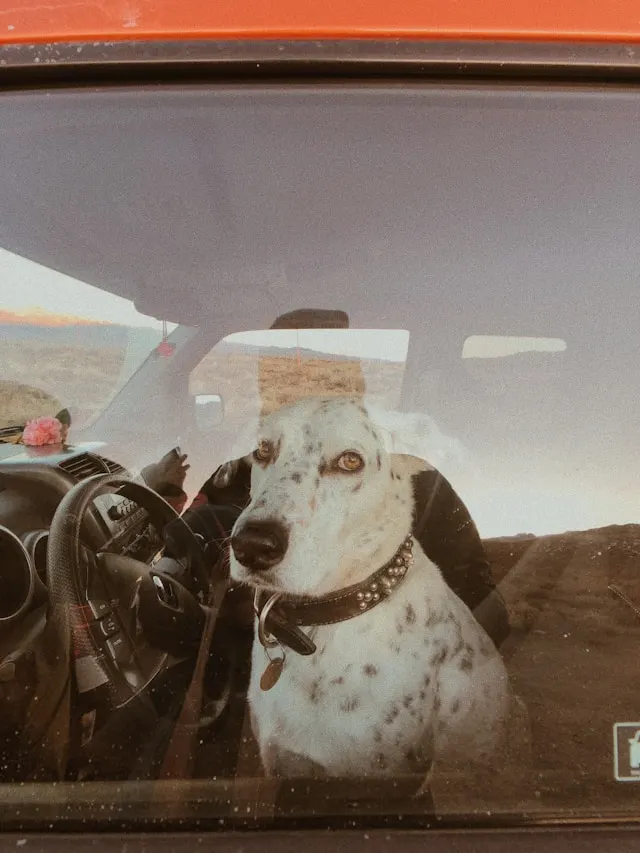Traveling with your dog in a car involves more than just packing their favorite toys and treats. Many states have specific laws governing how pets should be transported in vehicles, and staying informed about these regulations is essential for pet owners who travel across state lines. This comprehensive guide will help you understand the legal requirements for dog car travel across the United States in 2025.
This article is part of our comprehensive guide to dog car safety, helping you ensure legal compliance while traveling with your canine companion.

Table of Contents
Why Laws Exist for Pet Car Travel
Pet travel laws serve several important purposes:
- Safety for your pet: Proper restraints can prevent injury in sudden stops or accidents
- Safety for drivers: An unrestrained pet can be a major distraction
- Protection for others: Loose pets can interfere with driving and pose risks to other drivers
- Animal welfare: Regulations help ensure pets are transported humanely
Understanding how safety products are tested can help you select equipment that meets legal requirements. Learn more in our article on CPS Certification Explained: How Dog Car Safety Products Are Tested.
Types of Legal Requirements
State laws regarding dog car travel generally fall into several categories:
1. Restraint Requirements
Some states specifically require dogs to be restrained in moving vehicles. This may include:
- Safety harnesses
- Carriers or crates
- Vehicle barriers
- Seat belt attachments
For reviews of the best legally compliant restraint systems, see our guide to the Best CPS-Certified Dog Car Harnesses of 2025.
2. Truck Bed Regulations
Transporting dogs in the open bed of a pickup truck poses significant safety risks. Several states have laws that specifically address this practice, usually requiring the dog to be:
- In a secured crate
- Cross-tethered to prevent falling or jumping
- Protected from extreme weather conditions
3. Distracted Driving Laws
Even if a state doesn’t have specific pet restraint laws, many have distracted driving laws that could apply if an unrestrained pet interferes with safe vehicle operation.
4. Anti-Cruelty Provisions
Most states have animal cruelty laws that could apply to dangerous or inhumane transportation methods, such as leaving a dog exposed to extreme temperatures or unsafe conditions.
State-by-State Guide to Dog Car Travel Laws (2025)
States with Specific Restraint Laws
These states have explicit laws requiring dogs to be secured in moving vehicles:
New Jersey
New Jersey’s law is among the strictest in the nation. Under N.J.S.A. 4:22-18, pets must be properly secured in a pet carrier, harness, or other suitable restraint while in a moving vehicle. Violations can result in fines ranging from $250 to $1,000, and in some cases, could be considered a disorderly person’s offense under animal cruelty laws.
Rhode Island
Rhode Island’s law (R.I. Gen. Laws § 31-22-21.2) prohibits drivers from holding an animal in their lap and requires pets to be restrained or confined in an area of the vehicle where they cannot interfere with the driver’s control of the vehicle. The restraint must prevent the animal from reaching the driver’s seat area.
Hawaii
Hawaii state law requires dogs in moving vehicles to be restrained in a way that prevents them from falling, jumping, or being thrown from the vehicle. Dogs in truck beds must be cross-tethered or in a secured crate.
Massachusetts
Massachusetts requires pets to be secured in a harness, carrier, or other restraint to prevent distraction to the driver. The law specifically prohibits transporting animals in a way that endangers the animal’s health or safety.
Minnesota
Minnesota law requires all animals in vehicles to be secured in a way that prevents escape and provides for the animal’s safety. For truck beds, the animal must be in a secured kennel or cross-tethered.
Connecticut
Connecticut requires dogs in truck beds to be protected from the elements and secured to prevent falling or jumping from the vehicle. While the law doesn’t specifically mandate restraints inside the passenger compartment, distracted driving laws may apply.
States with Truck Bed-Specific Laws
These states have laws specifically addressing dogs transported in open truck beds:
California
California Vehicle Code Section 23117 prohibits transporting a dog in an open truck bed on a highway unless the dog is cross-tethered to the vehicle or protected by sides of sufficient height. The law also allows for transportation in a secured crate or cage.
Washington
Washington state law prohibits transporting dogs or other animals in or on any vehicle on a public highway unless they are safely enclosed within the vehicle or protected in a manner that prevents the animal from falling, jumping, or being thrown from the vehicle.
Oregon
Oregon law requires dogs transported in open truck beds to be protected with cross-tethering, a secured crate, or by sides of sufficient height to prevent falling or jumping. The law includes exceptions for farm dogs working on agricultural operations.
New Hampshire
New Hampshire requires animals in open vehicles to be properly secured in cages or other enclosures or sufficiently cross-tethered to the vehicle to prevent falling or escaping.
Arizona
Arizona law requires animals transported in pickup trucks to be either confined or secured to prevent the animal from falling, jumping, or being thrown from the vehicle.
Maine
Maine requires animals transported in open vehicles to be protected in a way that prevents injury and falling from the vehicle. This typically means secured carriers or cross-tethering for dogs in truck beds.
States with Applicable Distracted Driving Laws
These states don’t have specific pet restraint laws but have distracted driving statutes that could apply if an unrestrained pet interferes with driving:
New York
While New York doesn’t have specific laws about restraining pets in vehicles, its broad distracted driving laws could apply if an unrestrained animal interferes with driving. Additionally, local ordinances in some areas may have more specific requirements.
Florida
Florida’s distracted driving laws could apply to unrestrained pets that cause driver distraction. Additionally, leaving pets in vehicles under dangerous conditions (such as extreme heat) is specifically prohibited.
Texas
Texas doesn’t have a statewide pet restraint law, but its distracted driving laws could apply. Some local municipalities have enacted more specific ordinances, so check local regulations.
Illinois
Illinois’ distracted driving laws could apply to unrestrained pets. Additionally, several cities and counties have more stringent local ordinances requiring pet restraints in vehicles.
Pennsylvania
Pennsylvania’s distracted driving laws could apply to unrestrained pets in vehicles. The state does have specific laws against transporting animals in cruel or inhumane ways.
Michigan
Michigan’s distracted driving laws could apply to unrestrained pets. The state also has animal cruelty laws that could apply to dangerous transportation practices.
States with Minimal Regulations
Some states have few or no specific laws regarding dog car travel, though general animal welfare laws may still apply:
Wyoming
Wyoming has no specific laws regarding restraining pets in vehicles, but animal cruelty laws could apply to dangerous transportation methods.
South Dakota
South Dakota has no statewide laws specifically addressing pet restraint in vehicles, though some local ordinances may exist.
North Dakota
North Dakota has no specific pet restraint laws for vehicles, though reckless driving statutes could apply if an unrestrained pet causes dangerous driving conditions.
Mississippi
Mississippi doesn’t have specific laws about restraining pets in vehicles, though general animal welfare statutes could apply in extreme cases.
Alabama
Alabama doesn’t have specific laws mandating pet restraints in vehicles, but its distracted driving and animal welfare laws could apply in certain situations.
Interstate Travel Considerations
When traveling across state lines with your dog, consider these additional factors:
Health Certificate Requirements
Some states require health certificates for dogs entering from another state. These documents typically need to:
- Be issued by a licensed veterinarian
- Confirm vaccinations are current (especially rabies)
- Be obtained within a specific timeframe before travel (often 10-30 days)
For detailed, up-to-date information on state-specific pet travel regulations, consult the USDA APHIS Pet Travel Guide.
Quarantine Regulations
Some states, particularly Hawaii, have quarantine requirements for incoming pets. Always check destination requirements well in advance of travel.
National Park and Federal Land Rules
When visiting national parks or federal lands, be aware that they may have their own regulations regarding pets. These often include:
- Leash requirements (typically 6 feet or shorter)
- Restricted access to certain trails or areas
- Requirements to clean up after your pet
Long journeys can be stressful for many dogs. Learn how to manage travel anxiety in our guide to Dog Travel Anxiety: Prevention & Management Tips for Stress-Free Car Rides.
Best Practices for Legal Compliance
To ensure you’re complying with all relevant laws:
- Research in advance: Check the specific laws for any states you’ll be traveling through
- Use proper restraints: A crash-tested harness, carrier, or crate is safest and most likely to comply with various state laws. Not sure which restraint system is right for your dog? Our guide on How to Choose the Right Dog Car Safety Product Based on Size and Breed can help you make the best selection.
- Carry documentation: Bring proof of rabies vaccination and health certificates if required
- Never leave pets alone: In most states, leaving a pet unattended in a vehicle, especially in extreme temperatures, could result in animal cruelty charges
- Check local ordinances: Some cities and counties have stricter requirements than state law
Recommended Safety Equipment
To comply with the strictest state laws and ensure your pet’s safety, consider these options:
For Inside the Vehicle:
- Crash-tested harnesses: Look for those certified by the Center for Pet Safety (CPS)
- Secured carriers or crates: These should be anchored to the vehicle
- Vehicle barriers: These prevent pets from accessing the driver’s area
- Pet booster seats: These should be used with a harness for small dogs
For Truck Beds (if absolutely necessary):
- Secured, weather-resistant kennels
- Cross-tethering systems (never tether by the neck)
- Non-slip mats under crates or kennels
Insurance and Liability Considerations
Beyond legal compliance, consider these insurance aspects:
- Auto insurance: Unrestrained pets could potentially affect insurance claims if they contributed to an accident
- Pet insurance: Some policies cover injuries sustained in car accidents, though coverage varies
- Liability: If your unrestrained pet causes an accident, you could potentially face significant liability
Conclusion
While the patchwork of state laws regarding dog car travel can seem complex, the safest approach is to use crash-tested restraint systems regardless of your location. Not only does this help ensure compliance with varying legal requirements, but it also provides the best protection for your dog and everyone in the vehicle.
Before embarking on any interstate journey with your pet, take time to research the specific requirements of each state on your route. When in doubt, opt for the safer, more secure option—a properly restrained dog is a safer, happier travel companion.
Remember that laws can change, so it’s always a good idea to check with official state resources or a veterinarian familiar with travel requirements before your trip. Safe travels to you and your canine companion!
Frequently Asked Questions
Is it illegal to drive with an unrestrained dog in the car?
In many places, yes. Several U.S. states and European countries have specific laws requiring dogs to be restrained during car travel. Even where it’s not explicitly illegal, owners can be fined if an unrestrained dog is considered a distraction or safety risk.
Do dogs have to wear seat belts by law?
Not always. Some states and countries specifically require dog seat belts, while others allow crates or barriers as alternatives. Check your local regulations before traveling.
Can I let my dog ride in the front seat?
Most legal guidelines and safety experts advise against it. Airbags can cause serious injuries to dogs. Many regions require pets to be in the back seat or secured in the cargo area.
Is it illegal for dogs to ride in the bed of a pickup truck?
Yes, in many areas. Several states in the U.S. prohibit transporting dogs in open truck beds unless they are in a secured crate. This is to prevent accidents and injuries if the dog jumps or is thrown out.
Are there EU laws about dogs traveling in cars?
Yes. Countries like the UK, Germany, and Italy require dogs to be restrained using a harness, crate, or barrier. The exact rules differ, but fines can apply if you drive with an unsecured dog.
Can I be fined if my dog distracts me while driving?
Yes. Even if there isn’t a specific pet restraint law, most regions have “distracted driving” or “driving without due care” laws. If a police officer believes your dog interfered with safe driving, you can be fined or penalized.
Do airlines and ferries have different rules than cars?
Yes. Airlines follow IATA standards, requiring approved travel crates. Ferries and trains often have their own pet travel requirements, such as leashes, muzzles, or carriers. Always check with your carrier before traveling.
What’s the safest legal option for dog car travel?
A crash-tested crate or harness that meets your region’s legal standards. It keeps your dog secure, reduces distractions, and ensures compliance with laws.

